Come Say Hello at AWP & See the First 3D-Printed Broadside!
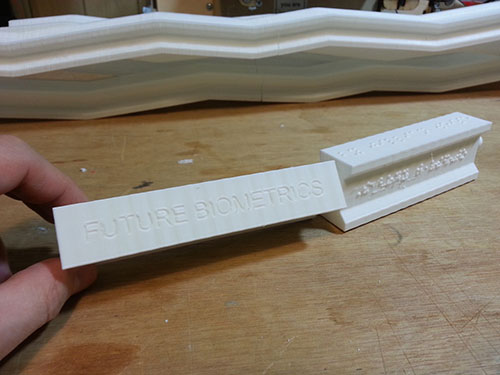
We say it every year, but be sure to stop by the Poetry Foundation table at AWP (booth 1303)! We'll have the ever-popular buttons, magazines, giveaways, and subscription deals, but also something extra special this year: a 3D-printed broadside. Jillian Weise’s “Future Biometrics,” from our March 2015 issue, is printed in Braille on one side and English on the other, and the couplets can be hinged together or recombined in new ways. The piece is beautifully designed and printed by Tom Burtonwood and the poem was translated into Braille by Sean Tikkun. You can read Jillian and Tom's thoughts on the process, and photos, below.
Most importantly: you can print your own! Follow this link to Thingiverse to download the files and print this broadside at your neighborhood library, school, or wherever there's a 3D printer. Tom offers more details on how to do this below.
Lastly: don't forget to see Jillian Weise, Jim Ferris, John Lee Clark, and Jennifer Bartlett at our panel, "Poetry & Disability," this Saturday, April 11, at 3PM (Room 200 D&E, Level 2). It's a continuation of the exchange we published on the topic in December 2014.
See you soon!
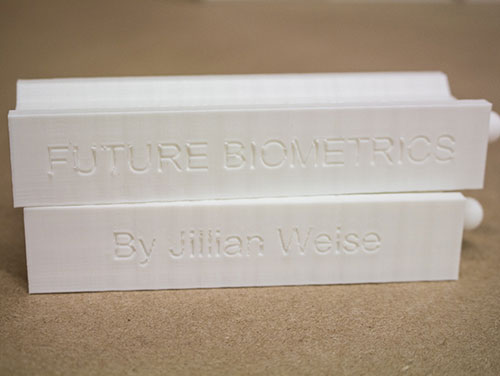
Jillian Weise: When Poetry pitched the idea of turning my poem into a 3D broadside, I had one question: What is a 3D broadside?
I witnessed a 3D printer at a Maker Faire several years ago. A machine the size of a car battery printed a plastic chess piece. It took forever. I figured 3D printers were for little things, lost things and broken things. I keep reading about how 3D printers are going to revolutionize medicine. Nobody I know has a plastic kidney. Not yet.
However, I’m all for it. I walk with a computerized leg and some of my parts are made by a multinational corporation. My relationship with the parent company can be dicey. I would like to change my software, but my parts are proprietary. So if I change something, I might void my warranty. Who can afford to void the warranty on her $30,000 leg these days? So I’m all for open source maker movements, DIY communities and 3D printers.
Emails with the Poetry editorial team, and the 3D artist, felt like learning a new language. Tom Burtonwood supplied us with incredible images and used a lexicon that includes: pin system, flexible joints, ABS versus PLA, variants, extrusions, iterations. Poems have always had iterations—from this draft to that draft, from codex to edX. I think maybe poems have always had extrusions too.
Tom’s version of "Future Biometrics" astounds me. One of the images reminds me of stalactites in a cave. One image of Braille lines reminds me of mass spectrometry DNA. As you know, the poem imagines that we can raise your daughters from the dead and put them in new, or lightly used, bodies. Until then, I invite you to 3D print the poem. Arrange the parts however you like.
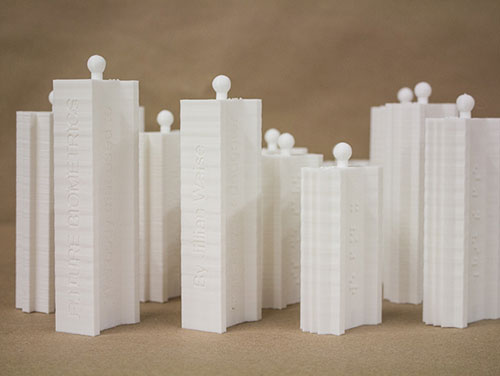
Tom Burtonwood: The inspiration for this project came out of a conversation I had with Fred Sasaki from the Poetry Foundation last summer. Fred visited my studio at the Art Institute of Chicago when I was Artist in Residence there in 2014. I had just published “Folium,” my second 3D printed book, which includes braille page numbers and corresponding braille descriptions for the 3D scanned bas relief works published in it from the AIC collection. Fred and I started talking about the possibilities of a 3D printed broadside using braille.
“Folium,” like “Future Biometrics,” is shared via the website Thingiverse. With “Folium” I used an OpenSCAD braille generator designed by Sean Tikkun to create the braille elements. OpenSCAD is an open source solid modeling tool used by many people in the 3D printing community. Rather than use a graphic user interface, OpenSCAD is a scripting environment, making it particularly well suited for parametric 3D modeling. Sean and I had been looking to collaborate on further projects and so this project with the Poetry Foundation seemed like a good fit for us.
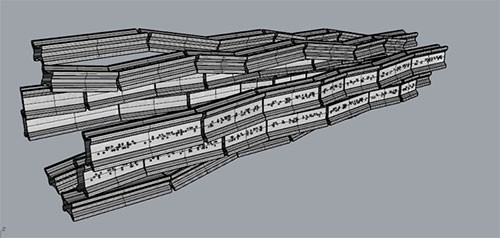
Sean translated Jillian Weise’s poem “Future Biometrics” into braille and sent me the files saved as STLs. In 3D printing the STL file format is analogous to the JPEG or GIF in photography and computer graphics. I designed the modules using Rhino 3D a computer modeling program used by industrial designers, architects and artists alike.
At first I wrapped the braille dots around a form modeled to resemble the DNA double helix. But we worried that this did not reflect the fracturing and trauma inherent in the poem. The next iteration was for an angular, Vorticist object with braille running along the faces on both sides. In this version I tried to represent a sense of anxiety while at the same time facilitating easy access to the braille.
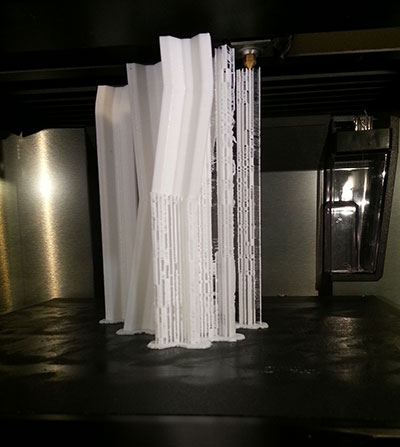
The final version came about from a thought to make each line from the poem an individual module and to connect them in a line with a popcorn joint embedded in the left side of each piece. We were concerned that the prior two versions, while impressive in size as 3D printed objects, would not be easily realizable on the average desktop 3D printer. In response to this I decided to break the poem up into smaller sections none of which any taller than 140mm, which most desktop machines can accommodate comfortably.
“Future Biometrics” is written in six couplets with one single line at the end. I designed each set of two modules with different extrusion profiles so that the couplets could hopefully be discerned purely by touch. On the right side of each module is also a braille number to indicate the order in which the pieces should be connected.
To print your own copy of the poem click this link to Thingiverse and download the STL files. There are 13 of them in total. They are oriented in the correct direction for printing on an plastic extrusion based desktop 3D printer. I recommend printing each module at 0.2mm layer height, 3 shells and 10-15% infill. They should print fine without rafts or support material.
The Thingiverse page also includes a zip file with the original braille STL files that Sean generated and the Rhino 3D file that I used to create the modules. To produce your own 3D printable braille dots, download OpenSCAD here and get Sean’s OpenSCAD braille generator from Thingiverse.


